Report: Learning and Teaching Plan for Imperial College Teachers
VerifiedAdded on 2020/06/06
|22
|5405
|111
Report
AI Summary
This report analyzes the role and responsibilities of teachers at Imperial College, focusing on learning and teaching plans, assessment methods, and inclusive practices. It explores various points of referral to meet the needs of learners, including organizational systems, external agencies, and government resources. The report emphasizes the importance of identifying and meeting individual learner needs to achieve quality education, develop talents, and schedule effective classroom activities. It details the role and use of initial and diagnostic assessments in establishing individual learning goals, along with various assessment methods such as written information appraisals, interviews, observations, and questionnaires. Furthermore, the report covers the recording of individual learning goals, scheme of work requirements, methods for formulating learning and teaching plans, and methods to promote equality and value diversity in teaching practices. The report also discusses how to establish and sustain a safe, inclusive learning environment, and ways to promote equality and value diversity in teaching. The report concludes by highlighting the importance of adapting teaching and learning approaches to meet the diverse needs of learners.
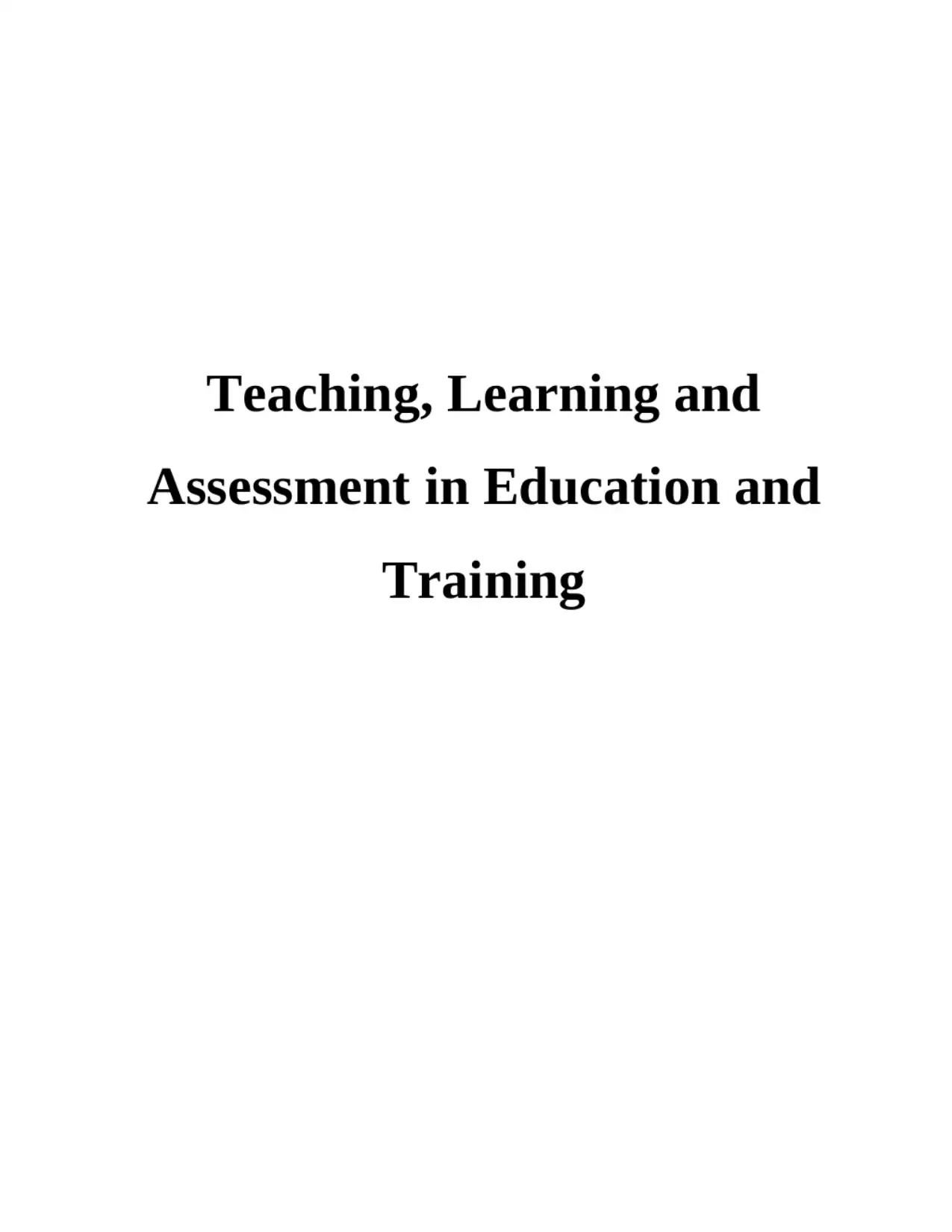
Paraphrase This Document
Need a fresh take? Get an instant paraphrase of this document with our AI Paraphraser
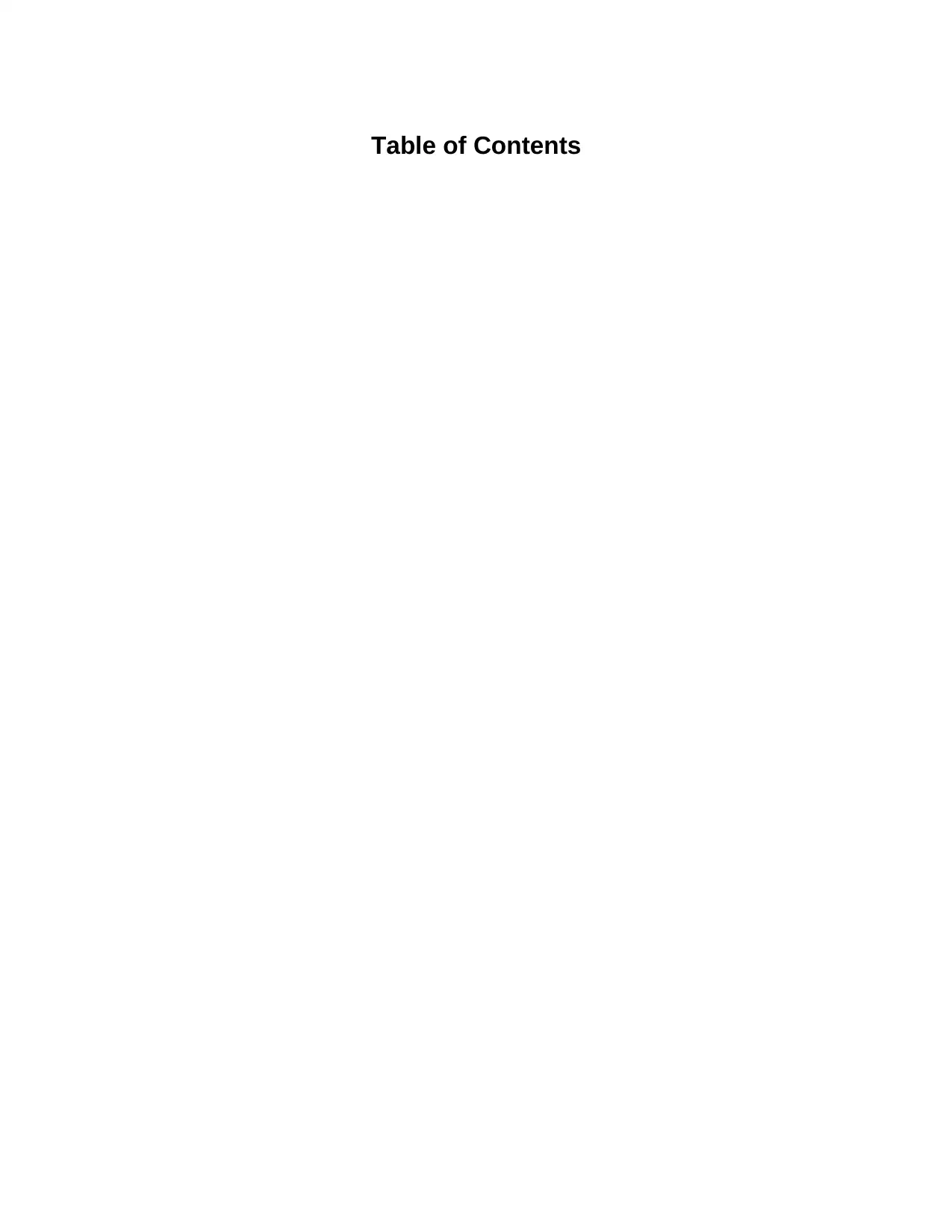
Table of Contents
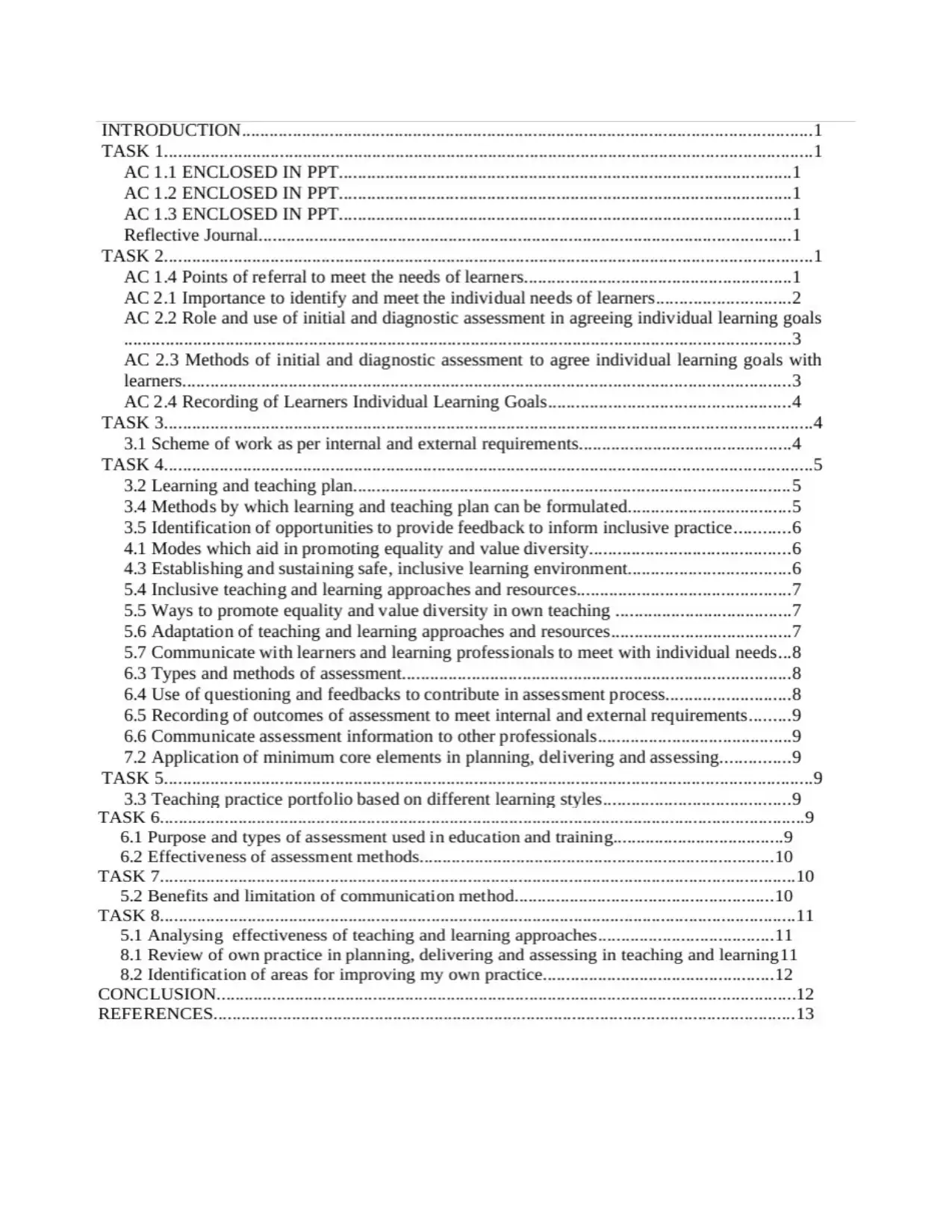
⊘ This is a preview!⊘
Do you want full access?
Subscribe today to unlock all pages.

Trusted by 1+ million students worldwide
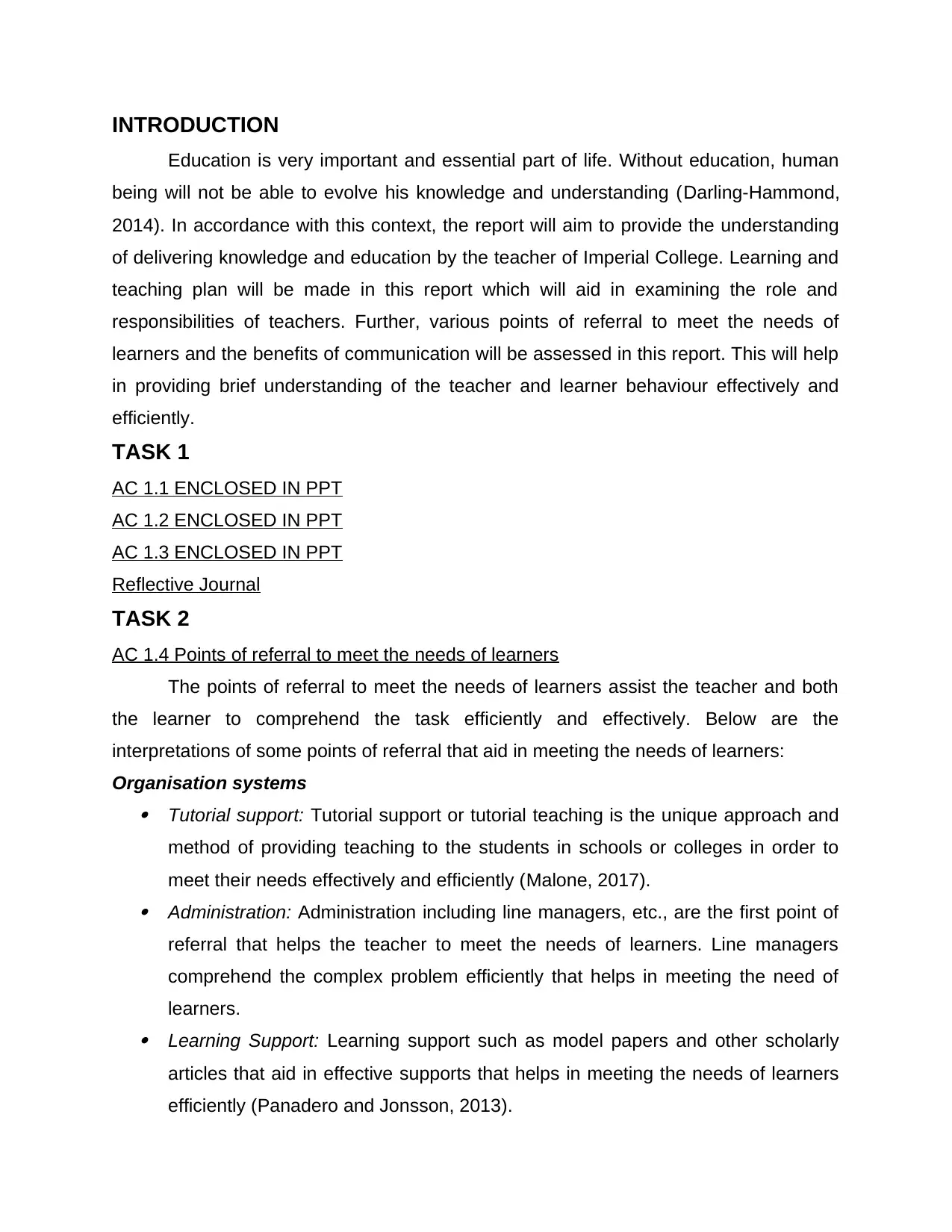
INTRODUCTION
Education is very important and essential part of life. Without education, human
being will not be able to evolve his knowledge and understanding (Darling-Hammond,
2014). In accordance with this context, the report will aim to provide the understanding
of delivering knowledge and education by the teacher of Imperial College. Learning and
teaching plan will be made in this report which will aid in examining the role and
responsibilities of teachers. Further, various points of referral to meet the needs of
learners and the benefits of communication will be assessed in this report. This will help
in providing brief understanding of the teacher and learner behaviour effectively and
efficiently.
TASK 1
AC 1.1 ENCLOSED IN PPT
AC 1.2 ENCLOSED IN PPT
AC 1.3 ENCLOSED IN PPT
Reflective Journal
TASK 2
AC 1.4 Points of referral to meet the needs of learners
The points of referral to meet the needs of learners assist the teacher and both
the learner to comprehend the task efficiently and effectively. Below are the
interpretations of some points of referral that aid in meeting the needs of learners:
Organisation systems Tutorial support: Tutorial support or tutorial teaching is the unique approach and
method of providing teaching to the students in schools or colleges in order to
meet their needs effectively and efficiently (Malone, 2017). Administration: Administration including line managers, etc., are the first point of
referral that helps the teacher to meet the needs of learners. Line managers
comprehend the complex problem efficiently that helps in meeting the need of
learners. Learning Support: Learning support such as model papers and other scholarly
articles that aid in effective supports that helps in meeting the needs of learners
efficiently (Panadero and Jonsson, 2013).
Education is very important and essential part of life. Without education, human
being will not be able to evolve his knowledge and understanding (Darling-Hammond,
2014). In accordance with this context, the report will aim to provide the understanding
of delivering knowledge and education by the teacher of Imperial College. Learning and
teaching plan will be made in this report which will aid in examining the role and
responsibilities of teachers. Further, various points of referral to meet the needs of
learners and the benefits of communication will be assessed in this report. This will help
in providing brief understanding of the teacher and learner behaviour effectively and
efficiently.
TASK 1
AC 1.1 ENCLOSED IN PPT
AC 1.2 ENCLOSED IN PPT
AC 1.3 ENCLOSED IN PPT
Reflective Journal
TASK 2
AC 1.4 Points of referral to meet the needs of learners
The points of referral to meet the needs of learners assist the teacher and both
the learner to comprehend the task efficiently and effectively. Below are the
interpretations of some points of referral that aid in meeting the needs of learners:
Organisation systems Tutorial support: Tutorial support or tutorial teaching is the unique approach and
method of providing teaching to the students in schools or colleges in order to
meet their needs effectively and efficiently (Malone, 2017). Administration: Administration including line managers, etc., are the first point of
referral that helps the teacher to meet the needs of learners. Line managers
comprehend the complex problem efficiently that helps in meeting the need of
learners. Learning Support: Learning support such as model papers and other scholarly
articles that aid in effective supports that helps in meeting the needs of learners
efficiently (Panadero and Jonsson, 2013).
Paraphrase This Document
Need a fresh take? Get an instant paraphrase of this document with our AI Paraphraser
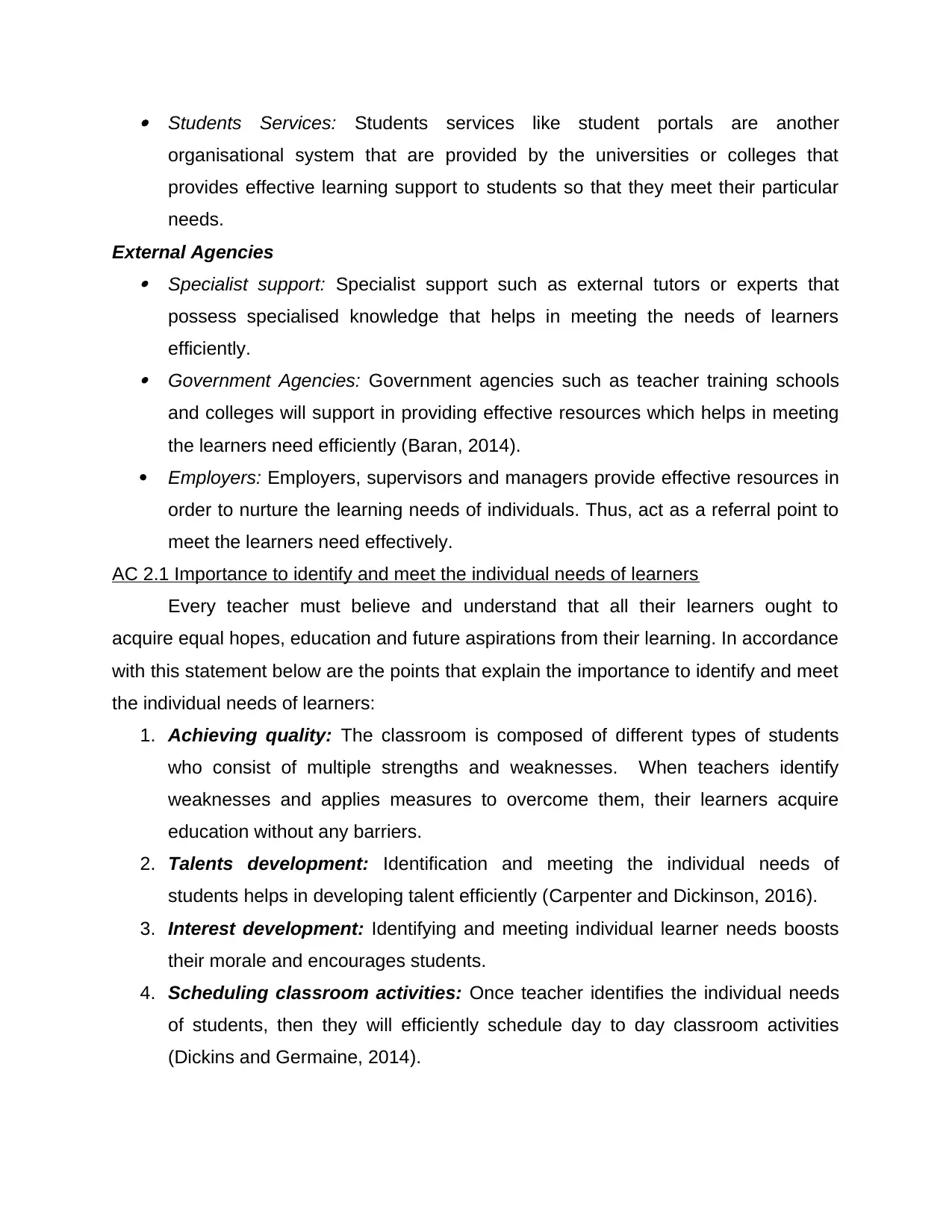
Students Services: Students services like student portals are another
organisational system that are provided by the universities or colleges that
provides effective learning support to students so that they meet their particular
needs.
External Agencies Specialist support: Specialist support such as external tutors or experts that
possess specialised knowledge that helps in meeting the needs of learners
efficiently. Government Agencies: Government agencies such as teacher training schools
and colleges will support in providing effective resources which helps in meeting
the learners need efficiently (Baran, 2014).
Employers: Employers, supervisors and managers provide effective resources in
order to nurture the learning needs of individuals. Thus, act as a referral point to
meet the learners need effectively.
AC 2.1 Importance to identify and meet the individual needs of learners
Every teacher must believe and understand that all their learners ought to
acquire equal hopes, education and future aspirations from their learning. In accordance
with this statement below are the points that explain the importance to identify and meet
the individual needs of learners:
1. Achieving quality: The classroom is composed of different types of students
who consist of multiple strengths and weaknesses. When teachers identify
weaknesses and applies measures to overcome them, their learners acquire
education without any barriers.
2. Talents development: Identification and meeting the individual needs of
students helps in developing talent efficiently (Carpenter and Dickinson, 2016).
3. Interest development: Identifying and meeting individual learner needs boosts
their morale and encourages students.
4. Scheduling classroom activities: Once teacher identifies the individual needs
of students, then they will efficiently schedule day to day classroom activities
(Dickins and Germaine, 2014).
organisational system that are provided by the universities or colleges that
provides effective learning support to students so that they meet their particular
needs.
External Agencies Specialist support: Specialist support such as external tutors or experts that
possess specialised knowledge that helps in meeting the needs of learners
efficiently. Government Agencies: Government agencies such as teacher training schools
and colleges will support in providing effective resources which helps in meeting
the learners need efficiently (Baran, 2014).
Employers: Employers, supervisors and managers provide effective resources in
order to nurture the learning needs of individuals. Thus, act as a referral point to
meet the learners need effectively.
AC 2.1 Importance to identify and meet the individual needs of learners
Every teacher must believe and understand that all their learners ought to
acquire equal hopes, education and future aspirations from their learning. In accordance
with this statement below are the points that explain the importance to identify and meet
the individual needs of learners:
1. Achieving quality: The classroom is composed of different types of students
who consist of multiple strengths and weaknesses. When teachers identify
weaknesses and applies measures to overcome them, their learners acquire
education without any barriers.
2. Talents development: Identification and meeting the individual needs of
students helps in developing talent efficiently (Carpenter and Dickinson, 2016).
3. Interest development: Identifying and meeting individual learner needs boosts
their morale and encourages students.
4. Scheduling classroom activities: Once teacher identifies the individual needs
of students, then they will efficiently schedule day to day classroom activities
(Dickins and Germaine, 2014).
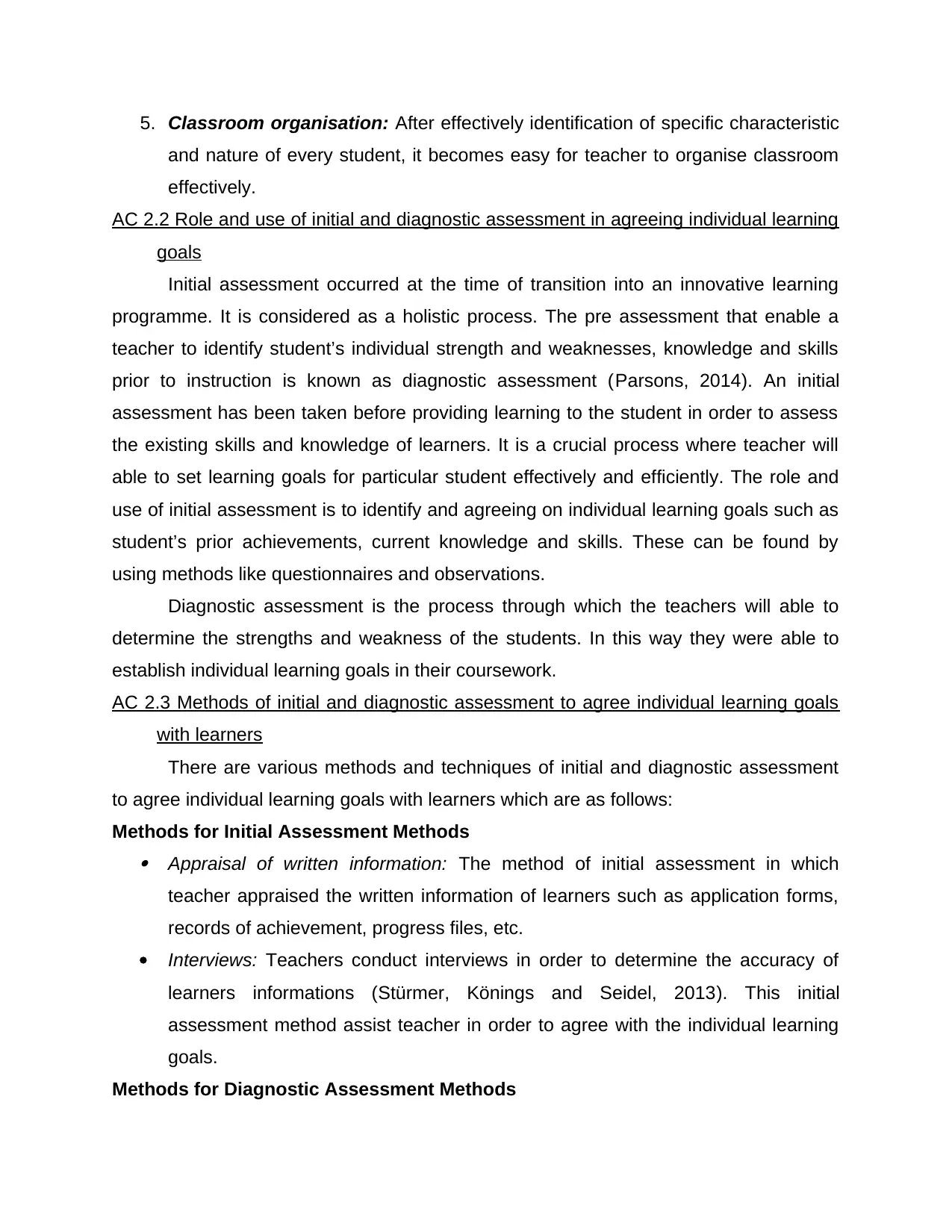
5. Classroom organisation: After effectively identification of specific characteristic
and nature of every student, it becomes easy for teacher to organise classroom
effectively.
AC 2.2 Role and use of initial and diagnostic assessment in agreeing individual learning
goals
Initial assessment occurred at the time of transition into an innovative learning
programme. It is considered as a holistic process. The pre assessment that enable a
teacher to identify student’s individual strength and weaknesses, knowledge and skills
prior to instruction is known as diagnostic assessment (Parsons, 2014). An initial
assessment has been taken before providing learning to the student in order to assess
the existing skills and knowledge of learners. It is a crucial process where teacher will
able to set learning goals for particular student effectively and efficiently. The role and
use of initial assessment is to identify and agreeing on individual learning goals such as
student’s prior achievements, current knowledge and skills. These can be found by
using methods like questionnaires and observations.
Diagnostic assessment is the process through which the teachers will able to
determine the strengths and weakness of the students. In this way they were able to
establish individual learning goals in their coursework.
AC 2.3 Methods of initial and diagnostic assessment to agree individual learning goals
with learners
There are various methods and techniques of initial and diagnostic assessment
to agree individual learning goals with learners which are as follows:
Methods for Initial Assessment Methods Appraisal of written information: The method of initial assessment in which
teacher appraised the written information of learners such as application forms,
records of achievement, progress files, etc.
Interviews: Teachers conduct interviews in order to determine the accuracy of
learners informations (Stürmer, Könings and Seidel, 2013). This initial
assessment method assist teacher in order to agree with the individual learning
goals.
Methods for Diagnostic Assessment Methods
and nature of every student, it becomes easy for teacher to organise classroom
effectively.
AC 2.2 Role and use of initial and diagnostic assessment in agreeing individual learning
goals
Initial assessment occurred at the time of transition into an innovative learning
programme. It is considered as a holistic process. The pre assessment that enable a
teacher to identify student’s individual strength and weaknesses, knowledge and skills
prior to instruction is known as diagnostic assessment (Parsons, 2014). An initial
assessment has been taken before providing learning to the student in order to assess
the existing skills and knowledge of learners. It is a crucial process where teacher will
able to set learning goals for particular student effectively and efficiently. The role and
use of initial assessment is to identify and agreeing on individual learning goals such as
student’s prior achievements, current knowledge and skills. These can be found by
using methods like questionnaires and observations.
Diagnostic assessment is the process through which the teachers will able to
determine the strengths and weakness of the students. In this way they were able to
establish individual learning goals in their coursework.
AC 2.3 Methods of initial and diagnostic assessment to agree individual learning goals
with learners
There are various methods and techniques of initial and diagnostic assessment
to agree individual learning goals with learners which are as follows:
Methods for Initial Assessment Methods Appraisal of written information: The method of initial assessment in which
teacher appraised the written information of learners such as application forms,
records of achievement, progress files, etc.
Interviews: Teachers conduct interviews in order to determine the accuracy of
learners informations (Stürmer, Könings and Seidel, 2013). This initial
assessment method assist teacher in order to agree with the individual learning
goals.
Methods for Diagnostic Assessment Methods
⊘ This is a preview!⊘
Do you want full access?
Subscribe today to unlock all pages.

Trusted by 1+ million students worldwide
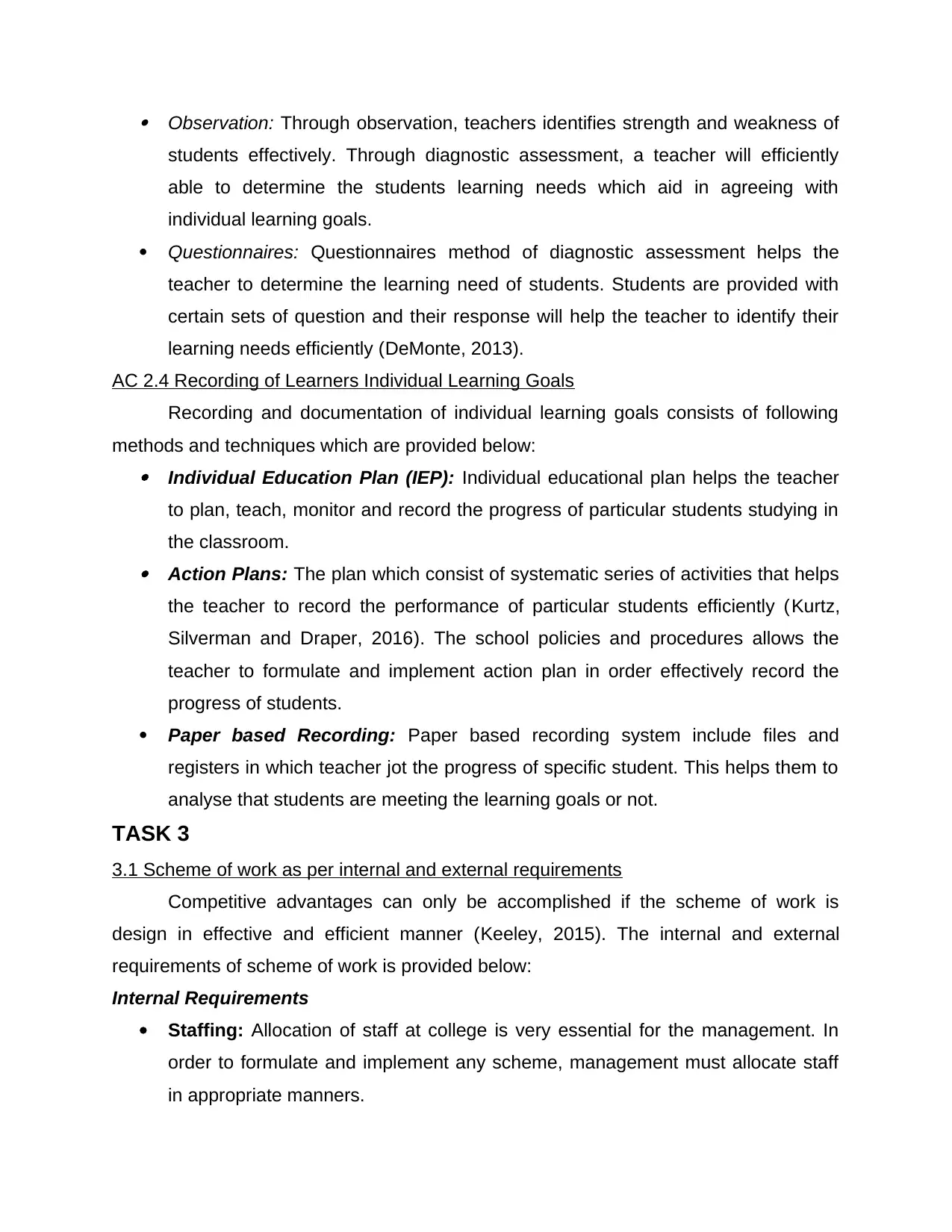
Observation: Through observation, teachers identifies strength and weakness of
students effectively. Through diagnostic assessment, a teacher will efficiently
able to determine the students learning needs which aid in agreeing with
individual learning goals.
Questionnaires: Questionnaires method of diagnostic assessment helps the
teacher to determine the learning need of students. Students are provided with
certain sets of question and their response will help the teacher to identify their
learning needs efficiently (DeMonte, 2013).
AC 2.4 Recording of Learners Individual Learning Goals
Recording and documentation of individual learning goals consists of following
methods and techniques which are provided below: Individual Education Plan (IEP): Individual educational plan helps the teacher
to plan, teach, monitor and record the progress of particular students studying in
the classroom. Action Plans: The plan which consist of systematic series of activities that helps
the teacher to record the performance of particular students efficiently (Kurtz,
Silverman and Draper, 2016). The school policies and procedures allows the
teacher to formulate and implement action plan in order effectively record the
progress of students.
Paper based Recording: Paper based recording system include files and
registers in which teacher jot the progress of specific student. This helps them to
analyse that students are meeting the learning goals or not.
TASK 3
3.1 Scheme of work as per internal and external requirements
Competitive advantages can only be accomplished if the scheme of work is
design in effective and efficient manner (Keeley, 2015). The internal and external
requirements of scheme of work is provided below:
Internal Requirements
Staffing: Allocation of staff at college is very essential for the management. In
order to formulate and implement any scheme, management must allocate staff
in appropriate manners.
students effectively. Through diagnostic assessment, a teacher will efficiently
able to determine the students learning needs which aid in agreeing with
individual learning goals.
Questionnaires: Questionnaires method of diagnostic assessment helps the
teacher to determine the learning need of students. Students are provided with
certain sets of question and their response will help the teacher to identify their
learning needs efficiently (DeMonte, 2013).
AC 2.4 Recording of Learners Individual Learning Goals
Recording and documentation of individual learning goals consists of following
methods and techniques which are provided below: Individual Education Plan (IEP): Individual educational plan helps the teacher
to plan, teach, monitor and record the progress of particular students studying in
the classroom. Action Plans: The plan which consist of systematic series of activities that helps
the teacher to record the performance of particular students efficiently (Kurtz,
Silverman and Draper, 2016). The school policies and procedures allows the
teacher to formulate and implement action plan in order effectively record the
progress of students.
Paper based Recording: Paper based recording system include files and
registers in which teacher jot the progress of specific student. This helps them to
analyse that students are meeting the learning goals or not.
TASK 3
3.1 Scheme of work as per internal and external requirements
Competitive advantages can only be accomplished if the scheme of work is
design in effective and efficient manner (Keeley, 2015). The internal and external
requirements of scheme of work is provided below:
Internal Requirements
Staffing: Allocation of staff at college is very essential for the management. In
order to formulate and implement any scheme, management must allocate staff
in appropriate manners.
Paraphrase This Document
Need a fresh take? Get an instant paraphrase of this document with our AI Paraphraser
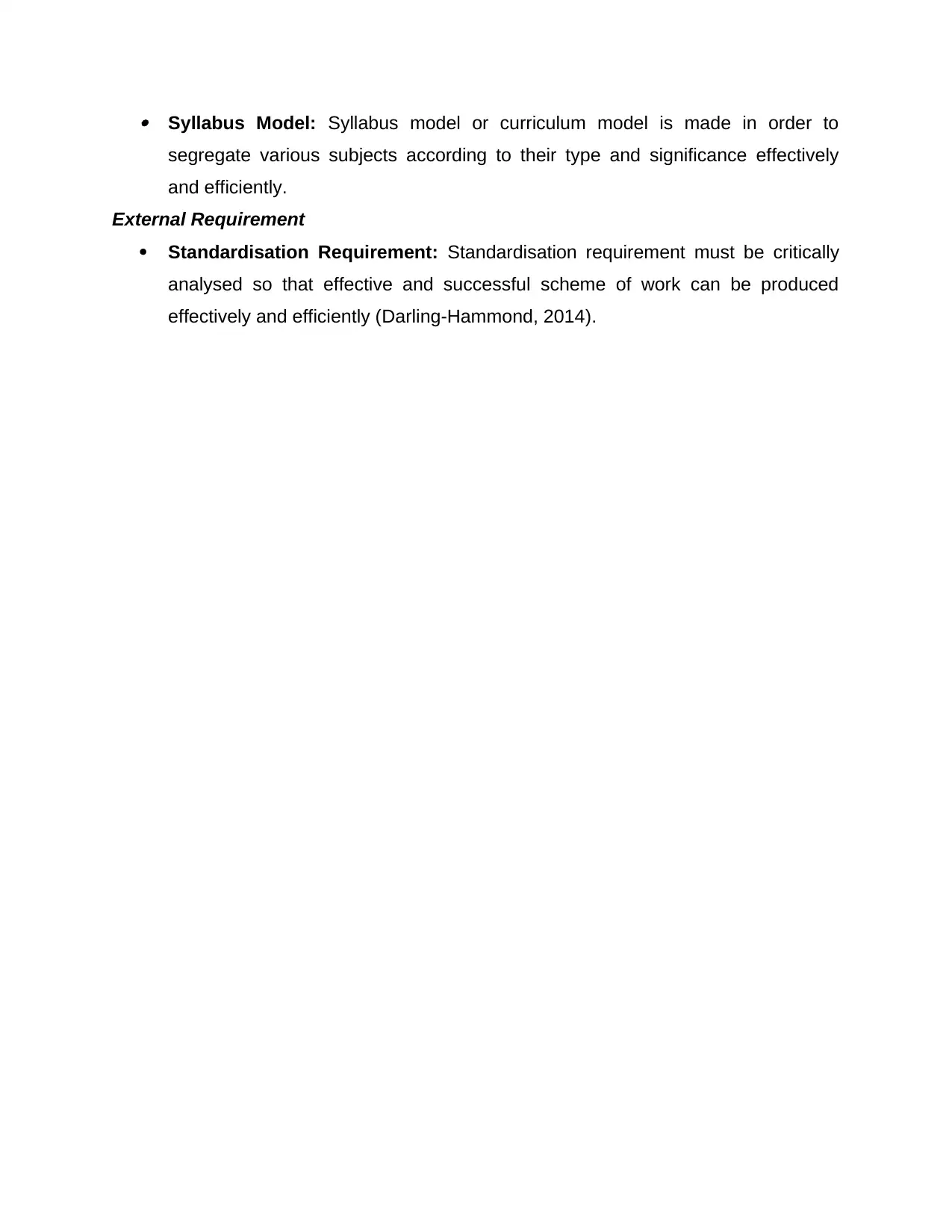
Syllabus Model: Syllabus model or curriculum model is made in order to
segregate various subjects according to their type and significance effectively
and efficiently.
External Requirement
Standardisation Requirement: Standardisation requirement must be critically
analysed so that effective and successful scheme of work can be produced
effectively and efficiently (Darling-Hammond, 2014).
segregate various subjects according to their type and significance effectively
and efficiently.
External Requirement
Standardisation Requirement: Standardisation requirement must be critically
analysed so that effective and successful scheme of work can be produced
effectively and efficiently (Darling-Hammond, 2014).
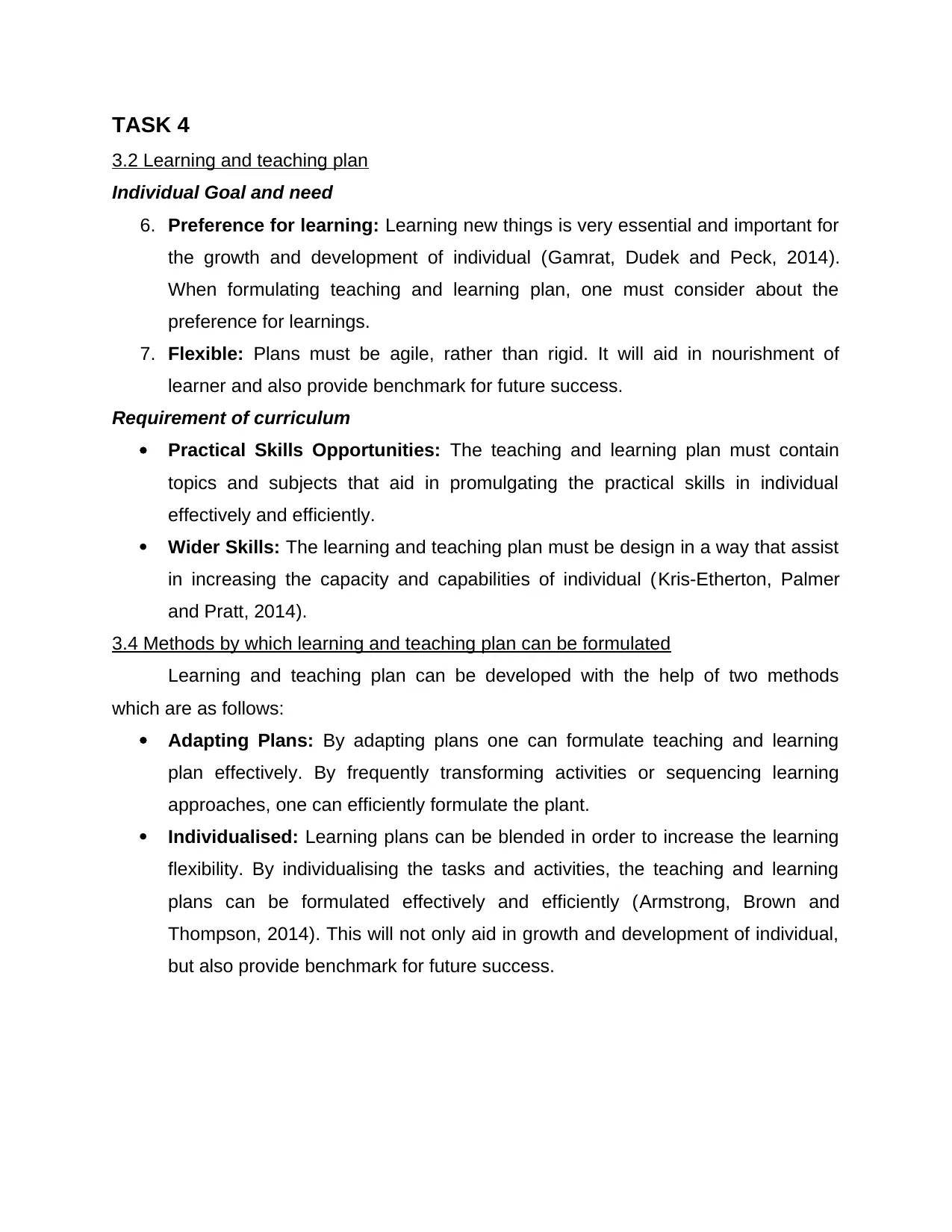
TASK 4
3.2 Learning and teaching plan
Individual Goal and need
6. Preference for learning: Learning new things is very essential and important for
the growth and development of individual (Gamrat, Dudek and Peck, 2014).
When formulating teaching and learning plan, one must consider about the
preference for learnings.
7. Flexible: Plans must be agile, rather than rigid. It will aid in nourishment of
learner and also provide benchmark for future success.
Requirement of curriculum
Practical Skills Opportunities: The teaching and learning plan must contain
topics and subjects that aid in promulgating the practical skills in individual
effectively and efficiently.
Wider Skills: The learning and teaching plan must be design in a way that assist
in increasing the capacity and capabilities of individual (Kris-Etherton, Palmer
and Pratt, 2014).
3.4 Methods by which learning and teaching plan can be formulated
Learning and teaching plan can be developed with the help of two methods
which are as follows:
Adapting Plans: By adapting plans one can formulate teaching and learning
plan effectively. By frequently transforming activities or sequencing learning
approaches, one can efficiently formulate the plant.
Individualised: Learning plans can be blended in order to increase the learning
flexibility. By individualising the tasks and activities, the teaching and learning
plans can be formulated effectively and efficiently (Armstrong, Brown and
Thompson, 2014). This will not only aid in growth and development of individual,
but also provide benchmark for future success.
3.2 Learning and teaching plan
Individual Goal and need
6. Preference for learning: Learning new things is very essential and important for
the growth and development of individual (Gamrat, Dudek and Peck, 2014).
When formulating teaching and learning plan, one must consider about the
preference for learnings.
7. Flexible: Plans must be agile, rather than rigid. It will aid in nourishment of
learner and also provide benchmark for future success.
Requirement of curriculum
Practical Skills Opportunities: The teaching and learning plan must contain
topics and subjects that aid in promulgating the practical skills in individual
effectively and efficiently.
Wider Skills: The learning and teaching plan must be design in a way that assist
in increasing the capacity and capabilities of individual (Kris-Etherton, Palmer
and Pratt, 2014).
3.4 Methods by which learning and teaching plan can be formulated
Learning and teaching plan can be developed with the help of two methods
which are as follows:
Adapting Plans: By adapting plans one can formulate teaching and learning
plan effectively. By frequently transforming activities or sequencing learning
approaches, one can efficiently formulate the plant.
Individualised: Learning plans can be blended in order to increase the learning
flexibility. By individualising the tasks and activities, the teaching and learning
plans can be formulated effectively and efficiently (Armstrong, Brown and
Thompson, 2014). This will not only aid in growth and development of individual,
but also provide benchmark for future success.
⊘ This is a preview!⊘
Do you want full access?
Subscribe today to unlock all pages.

Trusted by 1+ million students worldwide
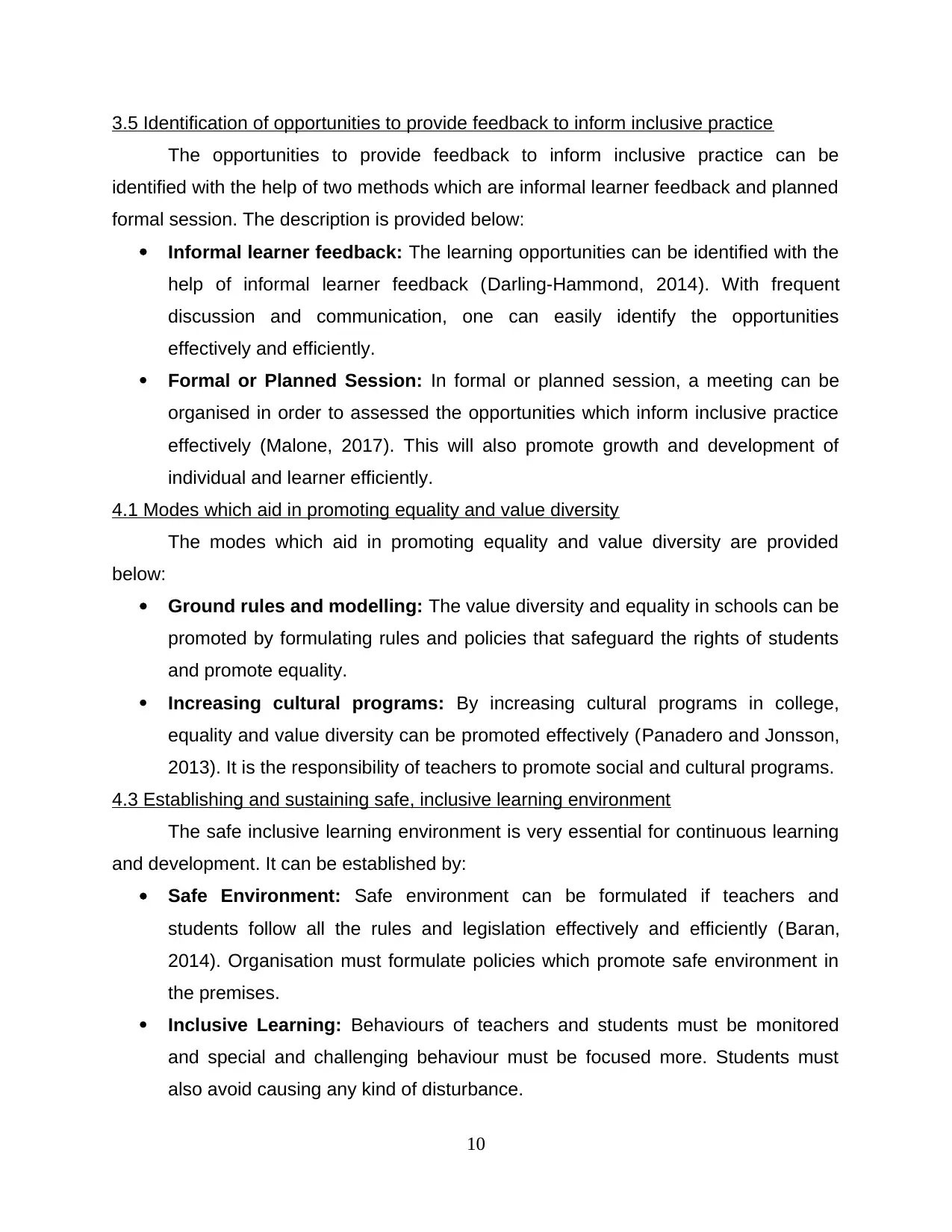
3.5 Identification of opportunities to provide feedback to inform inclusive practice
The opportunities to provide feedback to inform inclusive practice can be
identified with the help of two methods which are informal learner feedback and planned
formal session. The description is provided below:
Informal learner feedback: The learning opportunities can be identified with the
help of informal learner feedback (Darling-Hammond, 2014). With frequent
discussion and communication, one can easily identify the opportunities
effectively and efficiently.
Formal or Planned Session: In formal or planned session, a meeting can be
organised in order to assessed the opportunities which inform inclusive practice
effectively (Malone, 2017). This will also promote growth and development of
individual and learner efficiently.
4.1 Modes which aid in promoting equality and value diversity
The modes which aid in promoting equality and value diversity are provided
below:
Ground rules and modelling: The value diversity and equality in schools can be
promoted by formulating rules and policies that safeguard the rights of students
and promote equality.
Increasing cultural programs: By increasing cultural programs in college,
equality and value diversity can be promoted effectively (Panadero and Jonsson,
2013). It is the responsibility of teachers to promote social and cultural programs.
4.3 Establishing and sustaining safe, inclusive learning environment
The safe inclusive learning environment is very essential for continuous learning
and development. It can be established by:
Safe Environment: Safe environment can be formulated if teachers and
students follow all the rules and legislation effectively and efficiently (Baran,
2014). Organisation must formulate policies which promote safe environment in
the premises.
Inclusive Learning: Behaviours of teachers and students must be monitored
and special and challenging behaviour must be focused more. Students must
also avoid causing any kind of disturbance.
10
The opportunities to provide feedback to inform inclusive practice can be
identified with the help of two methods which are informal learner feedback and planned
formal session. The description is provided below:
Informal learner feedback: The learning opportunities can be identified with the
help of informal learner feedback (Darling-Hammond, 2014). With frequent
discussion and communication, one can easily identify the opportunities
effectively and efficiently.
Formal or Planned Session: In formal or planned session, a meeting can be
organised in order to assessed the opportunities which inform inclusive practice
effectively (Malone, 2017). This will also promote growth and development of
individual and learner efficiently.
4.1 Modes which aid in promoting equality and value diversity
The modes which aid in promoting equality and value diversity are provided
below:
Ground rules and modelling: The value diversity and equality in schools can be
promoted by formulating rules and policies that safeguard the rights of students
and promote equality.
Increasing cultural programs: By increasing cultural programs in college,
equality and value diversity can be promoted effectively (Panadero and Jonsson,
2013). It is the responsibility of teachers to promote social and cultural programs.
4.3 Establishing and sustaining safe, inclusive learning environment
The safe inclusive learning environment is very essential for continuous learning
and development. It can be established by:
Safe Environment: Safe environment can be formulated if teachers and
students follow all the rules and legislation effectively and efficiently (Baran,
2014). Organisation must formulate policies which promote safe environment in
the premises.
Inclusive Learning: Behaviours of teachers and students must be monitored
and special and challenging behaviour must be focused more. Students must
also avoid causing any kind of disturbance.
10
Paraphrase This Document
Need a fresh take? Get an instant paraphrase of this document with our AI Paraphraser
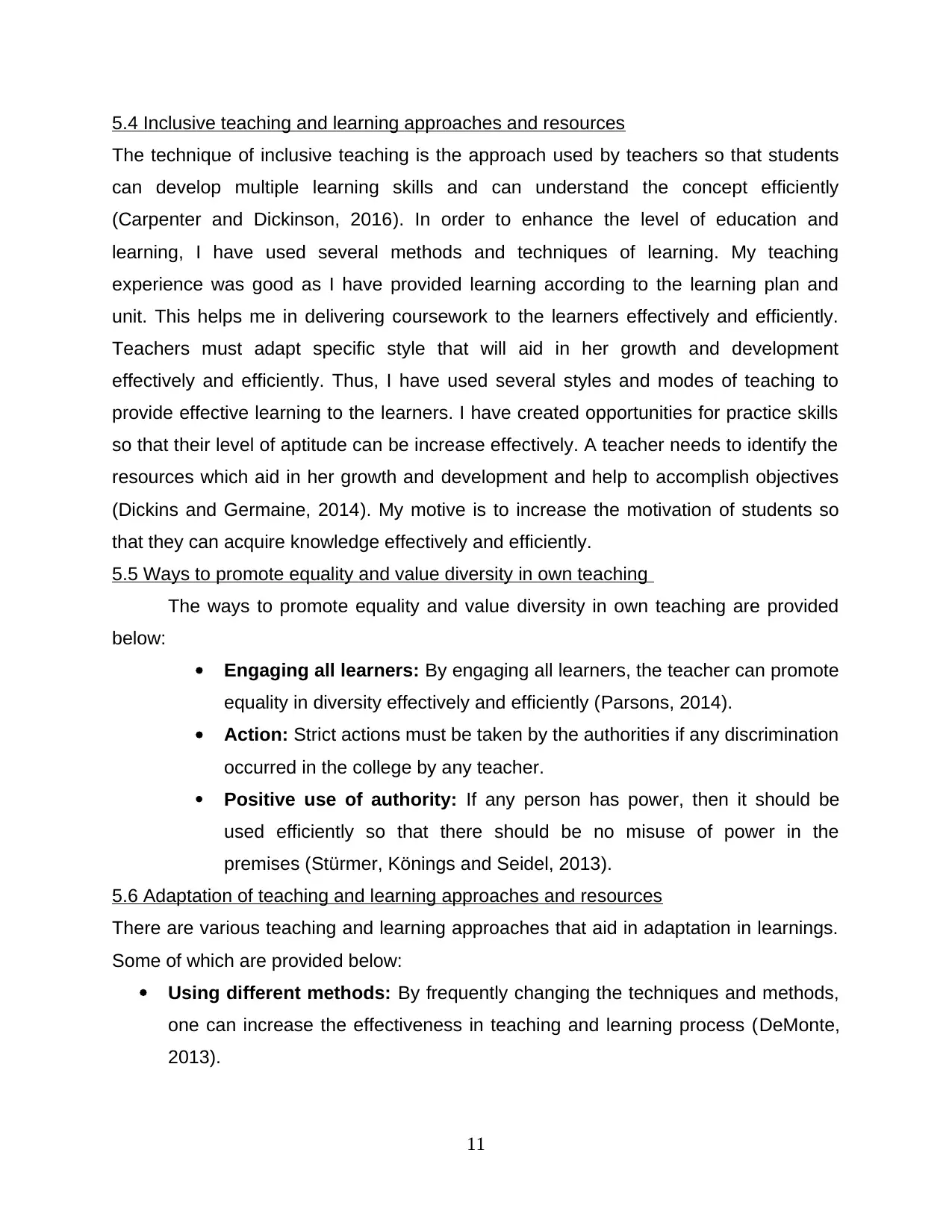
5.4 Inclusive teaching and learning approaches and resources
The technique of inclusive teaching is the approach used by teachers so that students
can develop multiple learning skills and can understand the concept efficiently
(Carpenter and Dickinson, 2016). In order to enhance the level of education and
learning, I have used several methods and techniques of learning. My teaching
experience was good as I have provided learning according to the learning plan and
unit. This helps me in delivering coursework to the learners effectively and efficiently.
Teachers must adapt specific style that will aid in her growth and development
effectively and efficiently. Thus, I have used several styles and modes of teaching to
provide effective learning to the learners. I have created opportunities for practice skills
so that their level of aptitude can be increase effectively. A teacher needs to identify the
resources which aid in her growth and development and help to accomplish objectives
(Dickins and Germaine, 2014). My motive is to increase the motivation of students so
that they can acquire knowledge effectively and efficiently.
5.5 Ways to promote equality and value diversity in own teaching
The ways to promote equality and value diversity in own teaching are provided
below:
Engaging all learners: By engaging all learners, the teacher can promote
equality in diversity effectively and efficiently (Parsons, 2014).
Action: Strict actions must be taken by the authorities if any discrimination
occurred in the college by any teacher.
Positive use of authority: If any person has power, then it should be
used efficiently so that there should be no misuse of power in the
premises (Stürmer, Könings and Seidel, 2013).
5.6 Adaptation of teaching and learning approaches and resources
There are various teaching and learning approaches that aid in adaptation in learnings.
Some of which are provided below:
Using different methods: By frequently changing the techniques and methods,
one can increase the effectiveness in teaching and learning process (DeMonte,
2013).
11
The technique of inclusive teaching is the approach used by teachers so that students
can develop multiple learning skills and can understand the concept efficiently
(Carpenter and Dickinson, 2016). In order to enhance the level of education and
learning, I have used several methods and techniques of learning. My teaching
experience was good as I have provided learning according to the learning plan and
unit. This helps me in delivering coursework to the learners effectively and efficiently.
Teachers must adapt specific style that will aid in her growth and development
effectively and efficiently. Thus, I have used several styles and modes of teaching to
provide effective learning to the learners. I have created opportunities for practice skills
so that their level of aptitude can be increase effectively. A teacher needs to identify the
resources which aid in her growth and development and help to accomplish objectives
(Dickins and Germaine, 2014). My motive is to increase the motivation of students so
that they can acquire knowledge effectively and efficiently.
5.5 Ways to promote equality and value diversity in own teaching
The ways to promote equality and value diversity in own teaching are provided
below:
Engaging all learners: By engaging all learners, the teacher can promote
equality in diversity effectively and efficiently (Parsons, 2014).
Action: Strict actions must be taken by the authorities if any discrimination
occurred in the college by any teacher.
Positive use of authority: If any person has power, then it should be
used efficiently so that there should be no misuse of power in the
premises (Stürmer, Könings and Seidel, 2013).
5.6 Adaptation of teaching and learning approaches and resources
There are various teaching and learning approaches that aid in adaptation in learnings.
Some of which are provided below:
Using different methods: By frequently changing the techniques and methods,
one can increase the effectiveness in teaching and learning process (DeMonte,
2013).
11
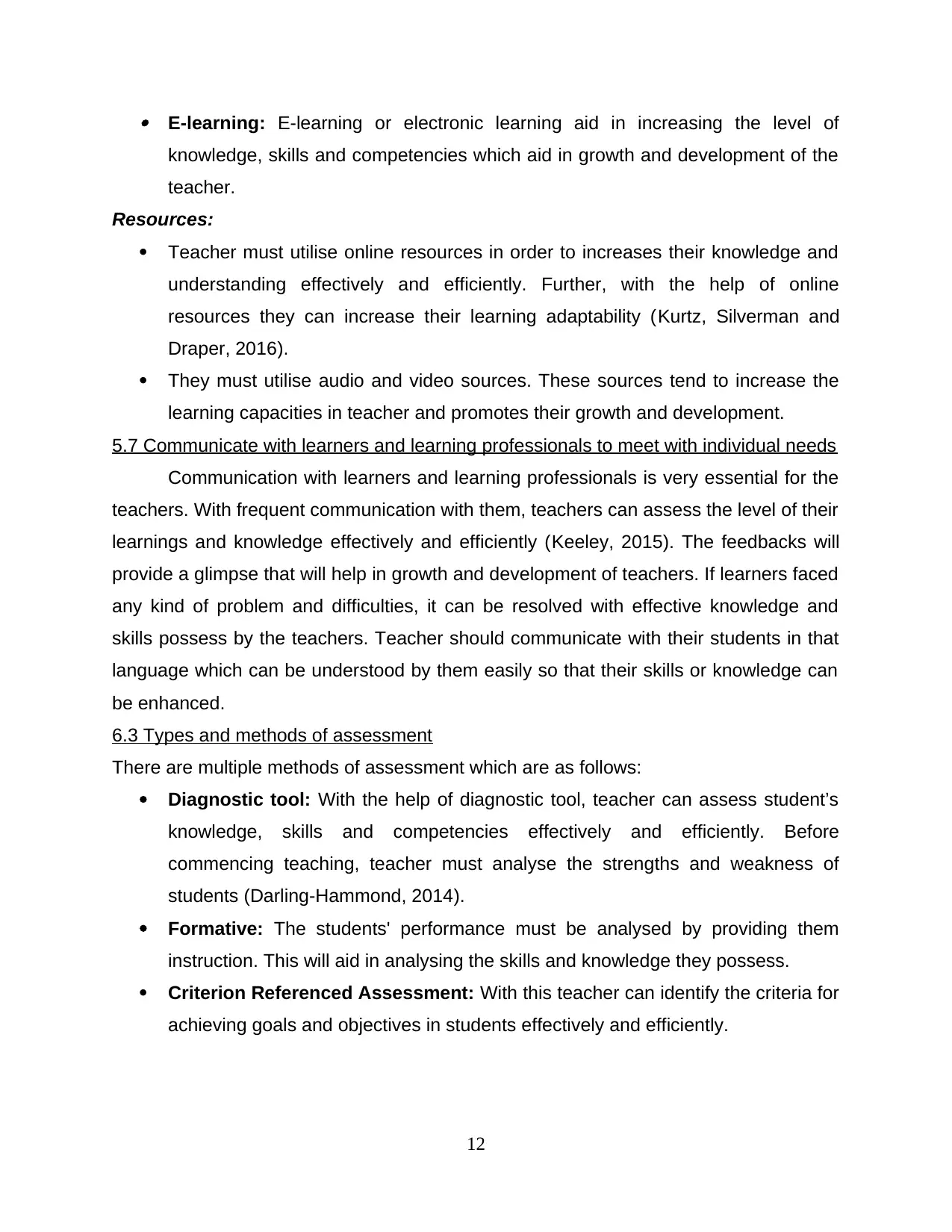
E-learning: E-learning or electronic learning aid in increasing the level of
knowledge, skills and competencies which aid in growth and development of the
teacher.
Resources:
Teacher must utilise online resources in order to increases their knowledge and
understanding effectively and efficiently. Further, with the help of online
resources they can increase their learning adaptability (Kurtz, Silverman and
Draper, 2016).
They must utilise audio and video sources. These sources tend to increase the
learning capacities in teacher and promotes their growth and development.
5.7 Communicate with learners and learning professionals to meet with individual needs
Communication with learners and learning professionals is very essential for the
teachers. With frequent communication with them, teachers can assess the level of their
learnings and knowledge effectively and efficiently (Keeley, 2015). The feedbacks will
provide a glimpse that will help in growth and development of teachers. If learners faced
any kind of problem and difficulties, it can be resolved with effective knowledge and
skills possess by the teachers. Teacher should communicate with their students in that
language which can be understood by them easily so that their skills or knowledge can
be enhanced.
6.3 Types and methods of assessment
There are multiple methods of assessment which are as follows:
Diagnostic tool: With the help of diagnostic tool, teacher can assess student’s
knowledge, skills and competencies effectively and efficiently. Before
commencing teaching, teacher must analyse the strengths and weakness of
students (Darling-Hammond, 2014).
Formative: The students' performance must be analysed by providing them
instruction. This will aid in analysing the skills and knowledge they possess.
Criterion Referenced Assessment: With this teacher can identify the criteria for
achieving goals and objectives in students effectively and efficiently.
12
knowledge, skills and competencies which aid in growth and development of the
teacher.
Resources:
Teacher must utilise online resources in order to increases their knowledge and
understanding effectively and efficiently. Further, with the help of online
resources they can increase their learning adaptability (Kurtz, Silverman and
Draper, 2016).
They must utilise audio and video sources. These sources tend to increase the
learning capacities in teacher and promotes their growth and development.
5.7 Communicate with learners and learning professionals to meet with individual needs
Communication with learners and learning professionals is very essential for the
teachers. With frequent communication with them, teachers can assess the level of their
learnings and knowledge effectively and efficiently (Keeley, 2015). The feedbacks will
provide a glimpse that will help in growth and development of teachers. If learners faced
any kind of problem and difficulties, it can be resolved with effective knowledge and
skills possess by the teachers. Teacher should communicate with their students in that
language which can be understood by them easily so that their skills or knowledge can
be enhanced.
6.3 Types and methods of assessment
There are multiple methods of assessment which are as follows:
Diagnostic tool: With the help of diagnostic tool, teacher can assess student’s
knowledge, skills and competencies effectively and efficiently. Before
commencing teaching, teacher must analyse the strengths and weakness of
students (Darling-Hammond, 2014).
Formative: The students' performance must be analysed by providing them
instruction. This will aid in analysing the skills and knowledge they possess.
Criterion Referenced Assessment: With this teacher can identify the criteria for
achieving goals and objectives in students effectively and efficiently.
12
⊘ This is a preview!⊘
Do you want full access?
Subscribe today to unlock all pages.

Trusted by 1+ million students worldwide
1 out of 22
Related Documents
Your All-in-One AI-Powered Toolkit for Academic Success.
+13062052269
info@desklib.com
Available 24*7 on WhatsApp / Email
![[object Object]](/_next/static/media/star-bottom.7253800d.svg)
Unlock your academic potential
Copyright © 2020–2025 A2Z Services. All Rights Reserved. Developed and managed by ZUCOL.





